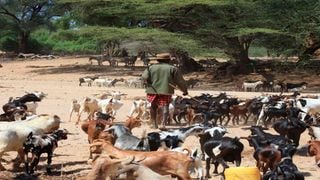
"When did you become a doctor of goats, my dear?” I asked Queen later that evening.
Turkana
Premium
Panic as goat plague strikes Turkana
What you need to know:
- The disease, Peste des petits ruminants (PPR), locally known as lomoo, had been declared endemic in Turkana by veterinary epidemiologists and other animal health experts when it became severe after locust invaded the region.
A highly contagious animal disease, popularly known as goat plague, is threatening livelihoods and food security in Turkana County.
The outbreak was first reported in November last year but efforts to eradicate the disease have fallen short.
The disease, Peste des petits ruminants (PPR), locally known as lomoo, had been declared endemic in Turkana by veterinary epidemiologists and other animal health experts when it became severe after locust invaded the region.
Lokori/Kochodin, Kapedo/Napeitom and Katilia wards in Turkana East sub-county were singled out as the hardest-hit, with community disease reporters aiding veterinary officers in surveillance in villages reporting confirmed cases.
Simon Pringan, a herder in Ngilukia village in Turkana East, said he had lost 22 goats to the disease that he said was characterised by fever, coughing, mouth sores, diarrhea and pneumonia.
“Some of the goats had discharge from the eyes and nose, which sometimes formed a crust, making breathing difficult and forcing eyes shut,” he said.
He noted that his village is in an area prone to insecurity forcing pastoralists to graze in large groups for security. That allows sick goats and sheep from various kraals to spread the disease to healthy ones.
Another herder, Joshua Ekitela, said most residents of Turkana are pastoralists and insecurity has been a major hindrance in efforts to provide disease surveillance and treat sick animals.
A poor road network makes matters worse and veterinary officers fear attacks from highway bandits.
Vaccination
One of the measures the county government has adopted to control the widespread and often fatal disease is vaccination, said Pastoral Economy executive Philip Aemun.
“A total of 45,000 sheep and goats were vaccinated in Turkana East sub-county as we step up surveillance to ensure targeted vaccination. In Turkana North and Turkana Central sub-counties, a total of 53,262 livestock were vaccinated and dewormed,” he said.
He singled out perennial insecurity and recurrent droughts, which have forced people to migrate to other areas, as some of the critical bottlenecks in efforts to eradicate goat plague and other livestock diseases in Turkana and neighboring communities.
He appealed to neighbouring counties, development partners and the national government to partner and coordinate efforts to control the disease.
“There is a need to build the capacity of county frontline personnel on animal disease surveillance using participatory methods with a focus on PPR eradication,” he said.
He said that through the use of smartphones, an innovative community-led syndromic livestock disease surveillance has been rolled out in Turkana.
Herders, through community disease reporters, collect and transmit surveillance data to veterinary officers.
Smartphones
The county government, in partnership with USAid’s Feed the Future and the International Livestock Research Institute(ILRI), has handed over 20 smartphones to community disease reporters.
“Through the e-surveillance system we are conducting targeted vaccination of livestock against PPR in Turkana East sub-county," he said.
County officials, he said, had proposed a policy and bill that are being developed by the veterinary directorate and livestock partners, saying this will strengthen disease surveillance in order to reach a state of disease-free zones for markets and biosafety.
County Director for Veterinary Services Benson Longor called on Turkana and West Pokot counties to exploit the prevailing peace and conduct collaborative livestock disease surveillance, vaccination and treatment to achieve better results.
PPR can potentially have a major impact on small animals. Outbreaks in 2006-2008 killed 1.2 million small ruminants, especially in arid and semi-arid counties, where livestock are the sole source of people’s livelihoods.
Dr Harry Oyas, head of disease surveillance in Kenya’s Directorate of Veterinary Services, promised comprehensive research that will inform proper eradication strategies in the affected counties that also include Mandera, Samburu and Marsabit.
He urged regular treatment and vaccination.





